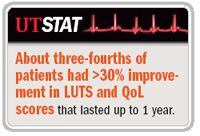Article
Botulinum toxin appears safe, effective in BPH/LUTS
Data from two Taiwanese studies presented at the 2007 AUA annual meeting on the use of botulinum toxin A (Botox) suggest that injections of the agent into the prostate are safe and effective in relieving the symptoms of BPH and that the treatment supplements the therapeutic benefits of medical treatment in men with larger glands.

Key Points

If these data are confirmed in additional studies, urologists may be able to add a relatively safe, effective, minimally invasive, office-based treatment to their BPH armamentarium.
Particularly in the case of men with BPH who have been identified as high surgical risks, the first study by Hann-Chorng Kuo, MD, a urologist at Buddhist Tzu Chi General Hospital in Hualien, Taiwan, is promising. In it, Dr. Kuo examined dose effectiveness and safety of the agent in relieving lower urinary tract symptoms related to BPH.
A second cohort of 30 men with similar symptoms who were receiving combination medical therapy was selected as controls. Baseline histology and measurements of IPSS, total prostate volume (TPV), Qmax, and PVR were taken for all participants.
Over a 3-month period, the treatment cohort received a total of 50 intraprostatic injections of botulinum toxin in increments of 200 U. One man re-ceived a total of 600 U; 18 men received 400 U; and 11 men received 200 U. Twelve of the men with TPV >80 mL were given doses of 400 U to 600 U; seven men with TPV <80 mL received 400 U.
Baseline and post-treatment data in the treatment group were compared: Mean IPSS decreased by 47%, TPV decreased by 23.5%, Qmax increased by 2.9 mL/second, and PSA decreased by 35.4%. In controls, no significant changes from baseline occurred except for a 32.5% reduction in IPSS. Histologic changes from baseline were found in seven men after their first injection. Biopsies after treatment showed that focal epithelial cell atrophy in the gland intensified at 3 months out and endured through 6 months post-treatment. Further, degenerative changes in smooth stromal muscle peaked immediately after treatment.
Treatment-related side effects included gross hematuria (seven patients), acute urinary retention (three patients), and acute prostatitis after a single injection. All resolved with treatment within 3 days.
Overall, therapeutic outcome in the treatment group was judged excellent in three men and improved in 22. Five men showed no improvement in symptoms, but none of these patients had worse outcomes after treatment. By comparison, only five controls improved; 25 had no change in symptoms. Overall rate of satisfaction with treatment outcomes was significantly higher in the treatment cohort than in controls (83% vs. 17%, p<.001).
Of significance, no clinical benefit was observed in patients who received add-on doses; however, men with TPV >80 mL required a dose >400 U to achieve satisfactory outcomes.
Claus G. Roehrborn, MD, of the University of Texas Southwestern Medical Center, Dallas, was skeptical about the results of this small study, pointing out that the 200-U dose has been shown to be ineffective in studies of dogs. Dr. Kuo was not present during the comment period.
Extended symptom relief
Dramatic symptom improvement and durable results with botulinum toxin A also were reported in a small study from Chang Gung University, Taiwan, and the University of Pittsburgh School of Medicine. Surprisingly, the study found that responsiveness to the treatment has little to do with prostate volume, before or after treatment.





